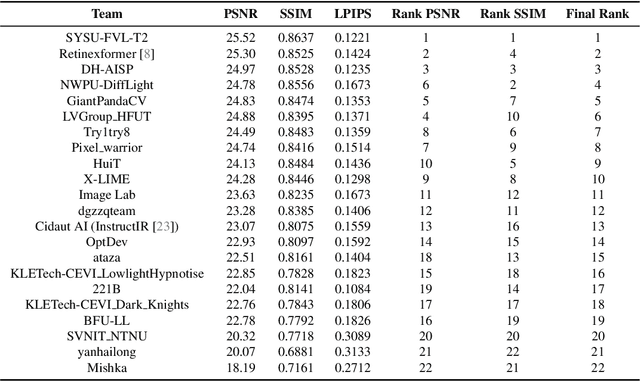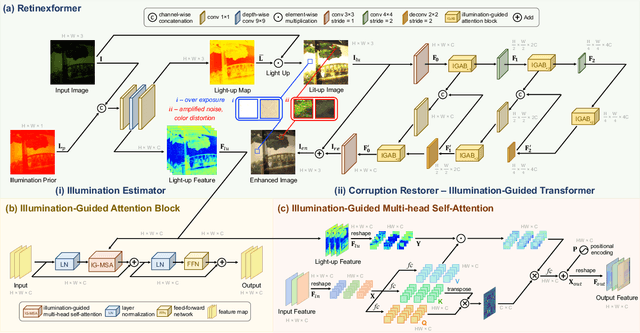Weipeng Yang
Wave-Mamba: Wavelet State Space Model for Ultra-High-Definition Low-Light Image Enhancement
Aug 02, 2024Abstract:Ultra-high-definition (UHD) technology has attracted widespread attention due to its exceptional visual quality, but it also poses new challenges for low-light image enhancement (LLIE) techniques. UHD images inherently possess high computational complexity, leading existing UHD LLIE methods to employ high-magnification downsampling to reduce computational costs, which in turn results in information loss. The wavelet transform not only allows downsampling without loss of information, but also separates the image content from the noise. It enables state space models (SSMs) to avoid being affected by noise when modeling long sequences, thus making full use of the long-sequence modeling capability of SSMs. On this basis, we propose Wave-Mamba, a novel approach based on two pivotal insights derived from the wavelet domain: 1) most of the content information of an image exists in the low-frequency component, less in the high-frequency component. 2) The high-frequency component exerts a minimal influence on the outcomes of low-light enhancement. Specifically, to efficiently model global content information on UHD images, we proposed a low-frequency state space block (LFSSBlock) by improving SSMs to focus on restoring the information of low-frequency sub-bands. Moreover, we propose a high-frequency enhance block (HFEBlock) for high-frequency sub-band information, which uses the enhanced low-frequency information to correct the high-frequency information and effectively restore the correct high-frequency details. Through comprehensive evaluation, our method has demonstrated superior performance, significantly outshining current leading techniques while maintaining a more streamlined architecture. The code is available at https://github.com/AlexZou14/Wave-Mamba.
NTIRE 2024 Challenge on Low Light Image Enhancement: Methods and Results
Apr 22, 2024



Abstract:This paper reviews the NTIRE 2024 low light image enhancement challenge, highlighting the proposed solutions and results. The aim of this challenge is to discover an effective network design or solution capable of generating brighter, clearer, and visually appealing results when dealing with a variety of conditions, including ultra-high resolution (4K and beyond), non-uniform illumination, backlighting, extreme darkness, and night scenes. A notable total of 428 participants registered for the challenge, with 22 teams ultimately making valid submissions. This paper meticulously evaluates the state-of-the-art advancements in enhancing low-light images, reflecting the significant progress and creativity in this field.
VQCNIR: Clearer Night Image Restoration with Vector-Quantized Codebook
Dec 16, 2023Abstract:Night photography often struggles with challenges like low light and blurring, stemming from dark environments and prolonged exposures. Current methods either disregard priors and directly fitting end-to-end networks, leading to inconsistent illumination, or rely on unreliable handcrafted priors to constrain the network, thereby bringing the greater error to the final result. We believe in the strength of data-driven high-quality priors and strive to offer a reliable and consistent prior, circumventing the restrictions of manual priors. In this paper, we propose Clearer Night Image Restoration with Vector-Quantized Codebook (VQCNIR) to achieve remarkable and consistent restoration outcomes on real-world and synthetic benchmarks. To ensure the faithful restoration of details and illumination, we propose the incorporation of two essential modules: the Adaptive Illumination Enhancement Module (AIEM) and the Deformable Bi-directional Cross-Attention (DBCA) module. The AIEM leverages the inter-channel correlation of features to dynamically maintain illumination consistency between degraded features and high-quality codebook features. Meanwhile, the DBCA module effectively integrates texture and structural information through bi-directional cross-attention and deformable convolution, resulting in enhanced fine-grained detail and structural fidelity across parallel decoders. Extensive experiments validate the remarkable benefits of VQCNIR in enhancing image quality under low-light conditions, showcasing its state-of-the-art performance on both synthetic and real-world datasets. The code is available at https://github.com/AlexZou14/VQCNIR.
 Add to Chrome
Add to Chrome Add to Firefox
Add to Firefox Add to Edge
Add to Edge